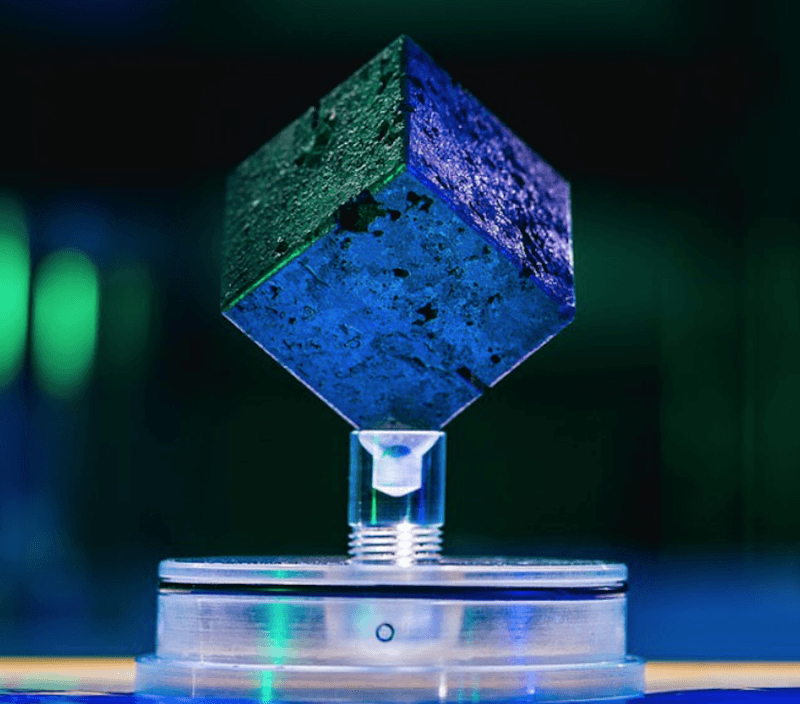A uranium cube anonymously sent to an American professor is said to be one of 664 uranium cubes that were used in the failed nuclear reactor built by the Nazis.

John T. Consoli/University of MarylandThe uranium cube once used in a Nazi nuclear reactor.
Timothy Koeth, a researcher at the University of Maryland, received a peculiar package one day in 2013. To his surprise, it was a cube of uranium from the 1940s that had apparently been used in the failed Nazi scheme to build a nuclear reactor.
According to the Daily Mail, when the cube of uranium was sent to the professor, it came with a crumpled note that read: “Taken from Germany, from the nuclear reactor Hitler tried to build. Gift of Ninninger.” Koeth was stunned but delighted.
“I just immediately knew what this thing was,” Koeth, a collector of nuclear memorabilia, said of the dark cube. But first, he needed to confirm the authenticity of the uranium cube to determine whether it was actually from Hitler’s failed nuclear reactor project.
Koeth teamed up with graduate student Miriam Hiebert to verify the cube’s origins. During their research, Koeth and Hiebert uncovered the stunning conclusion that Germany could have actually created a nuclear reactor during the war, but competition between separate research teams that had been working on the nuclear effort stymied the project’s success.
In the final stages of World War II, Nazi scientists had tried to build a nuclear reactor, the B-VIII, in Berlin yet eventually relocated to the small town of Haigerloch to continue the project.
As many as 664 uranium cubes, each measuring two inches on all sides like the one received by Koeth, were strung together like a chandelier. The uranium cubes were placed at the core of the B-VIII reactor and were surrounded by metal-encased graphite shell. The shell itself was located inside a concrete-lined water tank.
If the chandelier reactor was hung in heavy water, the water would act as a regulator for the nuclear reaction. But the project stalled due to a shortage of uranium for the reactor.
Among the German scientists who famously worked on the reactor was Werner Heisenberg, the theoretical physicist who is also credited with the development of the field of quantum mechanics. The Allied forces captured Heisenberg in 1945, while the nuclear reactor — or what had been built of it — was dismantled by U.S. troops at the end of the war.
The 664 cubes of uranium, so the story goes, were shipped to unknown locations in America.
According to Science News, the researchers looked through archival documents from the National Archives in College Park and found references to another 400 or so cubes that existed, yet were held by a different German research group. The scientists concluded that had the different groups combined forces, Germany would have had enough uranium to make a reactor.
As for the fate of the extra 400 cubes, they went onto the black market after the war with many of their locations lost to time.

Wikimedia CommonsReplica of the nuclear reactor at the Haigerloch museum in Germany.
As for the Nininger refernence in the note, it surely referred to Robert Nininger, an expert involved in the Manhattan Project that developed the first atomic bomb for the U.S. According to Nininger’s widow, the late scientist had once owned a piece of uranium but it was ultimately given away to a friend.
“As much as we’ve learned about our cube and others like it, we still don’t have an answer about how exactly it ended up in Maryland 70 years after being captured by Allied forces in southern Germany,” Heibert said.
So far, the researchers have located 10 other cubes. One of the 10 cubes that was uncovered is being held under the care of Harvard University, while another is located at the Smithsonian Institution in Washington, D.C.
“We hope to speak to as many people as possible who’ve had contact with these cubes,” Hiebert said, encouraging anyone with information regarding the rest of the lost uranium cubes to get in touch with the researchers by email.
Koeth plans to loan his cube to a museum where it can be inspected by the public while he and his research partner continue their quest for the rest of the missing uranium cubes.
Next, take a look at 35 haunting images from a town frozen in time by a nuclear meltdown. Then, read about the peacekeeper missile, the nuclear weapon so deadly that it had to be banned.





